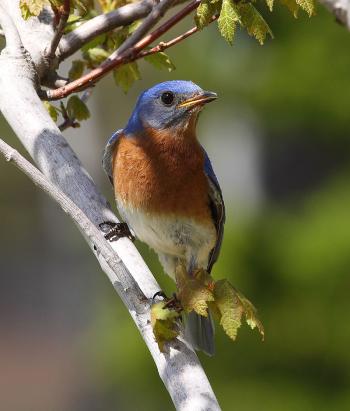
Eastern bluebirds winter in the coastal region of Louisiana but also can be found year round in the northern parishes. (Submitted Photo/Courtesy of John K. Flores)
April is the best month to greet feathered migrants
I couldn’t take it any longer. A couple of Sundays ago, just before church, I made my first excursion into the wilds of Bayou Teche National Wildlife Refuge. My hope was to see some early arriving feathered cosmopolitans.
Where a lot of guys get all cranked up about the sac-a-lait, bass and catfish biting each spring, migratory neotropic songbirds are what excite me. It’s not that I don’t enjoy fishing — Lord knows I do. I just prefer variety each spring doing a little of this and a little of that.
Funny, the “little of that” part of spring is indeed little, or more aptly put, very short in terms of duration. The spring songbird migration literally peaks by the third weekend in April and is pretty much over with by the second week of May.
But, during the migration, it’s not uncommon for an experienced birder to count upwards of 125 to 150 different species of birds in a full day.
However, you don’t have to be an experienced birder to enjoy the annual spring passage.
Though I’ve gotten pretty good at identifying quite a few species around these parts, what I personally enjoy about this passion of mine is seeing the birds that don’t reside in our state.
Rose-breasted grosbeaks, scarlet tanagers, magnolia, bay-breasted and yellow warblers, Baltimore orioles and various tyrant flycatchers are just some of the species that, on any given day during this migratory period, you have a chance of seeing in April.
But, there also are many species that migrate in from the tropics each spring and set up home right here in the Atchafalaya Basin and our coastal marshes.
Some of my favorites are the prothonotary and hooded warblers, painted and indigo buntings, yellow-breasted chat, yellow-billed cuckoo, and the great-crested flycatcher. All of which, I have seen on Bayou Teche National Wildlife Refuge.
Mix these summer visitors with our year round bird population that includes species such as the common yellowthroat, tufted titmouse, downy, hairy, red-bellied and pileated woodpeckers and barred owls and what you have is an avian extravaganza.
Speaking of extravaganzas, April is also bird festival time. The 2015 Great Louisiana Bird Festival is slated for April 10-12 this year. Held in Mandeville on the north shore of Lake Pontchartrain, the region is teeming with migrating songbirds during this time of year.
The following weekend, the Grand Isle Migratory Bird Celebration will be held April 17-19. The Grand Isle event features “open yards,” where attendees can walk the streets of the island’s residential area and literally observe migrating birds in people’s yards that have signs posted.
During the Grand Isle celebration, there is also opportunity to see incredible numbers of migrating shore birds. There are plovers, dunlins, turnstones, whimbrels, willets and stilts galore to see.
In early May, there is also the Neotropic Songbird Tour that takes place on Sherburne Wildlife Management Area just east of Lafayette. The songbird tour has several activities going on simultaneously. Representatives from the Louisiana Department of Wildlife and Fisheries are on hand putting on a mist net demonstration, banding songbirds.
Bayou Teche National Wildlife Refuge also is loaded with wading birds, such as great blue herons, great egrets, little blue herons, tri-colored herons, black-crowned night herons and yellow-crowned night herons.
Also present, though perhaps a bit shyer, is the green heron.
It pays to whisper and walk slowly when on a birding expedition. Though many species like the northern parula, cardinal, Carolina wren and white ibis tend to tolerate humans extremely well, they still get uncomfortable when pressured.
I’m also of the opinion that if you simply can’t put the fishing pole down for one nature viewing day in April, then make it a combo fishing and birding adventure. My lovely wife Christine and I do this annually.
We’ll travel into the basin to fish chinquapins, and when we have periods of inactivity, will pull our binoculars and cameras out and do a little birding.
In Flat Lake, we have observed bald eagles, wood ducks, prothonotary warblers, northern parulas, tufted titmouse, pileated woodpeckers, black and white warblers and numerous wading birds.
I have to admit, I got a little over anxious back in mid-March hoping to greet some of our neotropical friends from central and south America back home for the summer.
One thing for sure. Now that we’re into April, I need to get back out on the refuge.
If I don’t, they’re liable to pass us by. And, being one of the official greeters, I wouldn’t want to miss seeing them and knowing I didn’t even try to say hello.
If you wish to make a comment or have an anecdote, recipe or story you wish to share, you can contac Flores at 985-395-5586 or gowiththeflo@cox.net or visit his website at www.gowiththeflooutdoors.com.
- Log in to post comments
